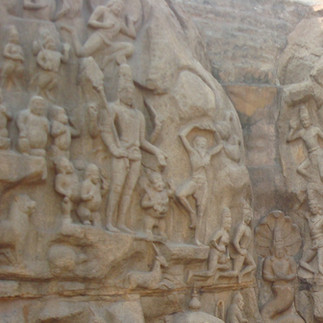Mahabalipuram : Masterpiece of Rock – cut Architecture / Sculptures
- kamalparu
- Jul 18, 2021
- 4 min read
Updated: Jun 29, 2024
Mahabalipuram : Masterpiece of Rock – cut Architecture / Sculptures

The Shore Temple , Mahabalipuram

· After paying obeisance to Lord Venkateswara at Tirumala Tirupati Devasthanam , we headed towards Chennai. Next morning we started journey for Mahabalipuram located mid-way on scenic East Coast Road connecting Chennai to Puducherry. En route we visited Crocodile park which upkeeps large varieties of crocodiles, alligators, turtles & snakes. We found it very informative not only for children but for all age group also.
· On reaching Mahabalipuram , we witnessed a number of rock – cut architectural marvels spread at three locations which mesmerized all of us. The group of monuments are distinctly divided at three locations :
(i) The Panch Rathas ( Five Rathas / chariots)
(ii) The Hill area & Arjuna’s Penance
(iii) The Shore Temple
· Due to unique and splendid treasure of rock cut architecture & sculptures, Mahabalipuram was recognized as the World Heritage Site by UNESCO in 1984. These monuments dating from the 6th to 10th century CE, built by successive rulers of the Pallava dynasty. The most of the monuments were constructed under the great Pallava ruler Narsimhavarman I (circa CE 630 – 70) who was also called ‘Mamalla’ from which this place derive it’s another name as ‘Mamallapuram’.
Brief details about monuments
1. The Panch Rathas : Legends of Mahabharata carved out of stone
This group of monuments consists of five monolithic chariot shaped temples hewed out of single piece of granite stone. These temples are placed in a sequence representing the Pandavas.
(i) Draupadi ratha - The most elegant temple in this group of monuments. Goddess Durga statue is placed inside. Lion ,the carrier of goddess built in front of it. Statues of dvarapalikas, makaratorana etc have been depicted on the side walls.
(ii) Arjuna ratha - Dedicated to Lord Shiva. Statue of Lord Vishnu, Indra, other deities, saints etc have been sculpted. A statue of Nandi – the carrier of Lord Shiva – built on back side.
(iii) Bhim ratha – Biggest in size of all rathas. It is dedicated to Lord Vishnu.
(iv) Dharmaraja ratha - The temple is a pyramidal structure and the highest among all rathas. Dedicated to Lord Shiva but Lord Brahma statue also sculptured on the panels at corners. On one of the famous panel, Lord Shiva depicted as ‘Ardhanarisvara’ – a combination of Shiva and Parvati. The perfect balancing of the masculine features and weapons of the Shiva - half and the graceful anatomical details and the delicate lotus in the Parvati - half figure makes it the most delightful sculpture .
Another famous panel depict ‘Harihara’ , believed to represent the Pallava ruler Sri Narasimha.
(V) Nakul – Sahadeva ratha – A small porch is built in front side of ratha. A colossal monolithic elephant placed near this temple.
The most striking fact about the Panch Rathas group of monuments is that though places related to Mahabharata period such as Hastinapur, Kurukshetra, Gandhar, Anga etc. are mentioned in the great epic, but no significant monument has been found at any of these places as reminiscent. The locations of various events related to Mahabharata period mostly fall in North and North-west India, but the legend of Mahabharata have been intricately carved out of stone at Mahabalipuram located in South India.
Panch Rathas
2. The Hill area & Arjuna’s Penance :
(i) Arjuna’s Penance – The famous bas – relief of Arjuna’s penance is carved out on the face of a huge granite rock piece. This magnificent carving is unique and the finest specimen of bas-relief art.
Various gods and goddess such as Chandra, Surya, pairs of kinnars & siddhas, Gandharvs, apsaras etc. flying towards a central point near the cleft where a sage stands on his left leg engrossed in penance. Images of Lord Shiva, sages, hunters, wild animals like lion, tiger, elephant ,monkeys, deer & boar, Nagas, Nagi, river Ganga descending on the earth etc. have been shown very intricately.
It is believed that the various scenes depicted in this bas-relief represent a story from the Mahabharata in which Arjuna performed penance to please Lord Shiva and to obtain the Pasupata weapon from him.
Arjuna's Penance - A Specimen of Bas - relief
(ii) Mahishamardini cave – The cave is famous for goddess Durga shown in the relief as eight-armed, riding on lion, equipped with various weapons and using bow with its string pulled to her ear. A number a of ganas and yoginis are accompanying her. Statue of Lord Shiva and famous Seshasayi Vishnu panels are also inside cave/mandapam.
Mahishamardini Cave
(iii) Olakkannisavara Temple & Light House –
Located on the top of hill, the temple is dedicated to Lord Shiva popularly known as ‘Flame-eye Shiva’.
A picturesque light house is located nearby from which we can have panoramic view of the Shore temple and blue sea.
(iv) Krishna’s Butterball - A huge granite boulder ( of size 6 m x 5 m approx.) resting on a sloping rock surface is a popular point of attraction for all visitors.

Krishna's Butterball
3. The Shore Temple :
· Located on the coastline, this is the finest example of a stone masonry temple built during the Pallava ruler Narasimhavarman II also called Rajasimha (circa AD 700 – 728).
· The vimana top is very elegant with a small gopuram on the entrance.
· Statues of Lord Shiva, Lord Vishnu and the Pallava ruler Rajasimhesvara are placed inside different temples.
· Rows of Nandi, carrier of Lord Shiva, are arranged along periphery of temple.
· It is believed that this temple had been under sea for a certain period of time.

Other places of attraction : Crocodile Park
Crocodile Park
Video of Mahabalipuram
# Mahabalipuram has served as venue for meeting of Head of states of India and China in October 2019. It was selected as the most preferred venue due to the fact that Chinese coins of ancient times have been recovered from here during archaeological excavation which indicates about existence of flourishing trade relation between two countries in old times.
# The exquisitely rock–cut architectural marvels, religious philosophy and artistic expressions of Mahabalipuram transcend time, history and geographical boundaries. We all should make endeavour to protect and preserve these temples/monuments which are real treasure of India’s rich architectural as well as cultural heritage. A visit to these heritage sites imparts peace and satisfaction to the visitors.
*******







































































Very well covered and described.